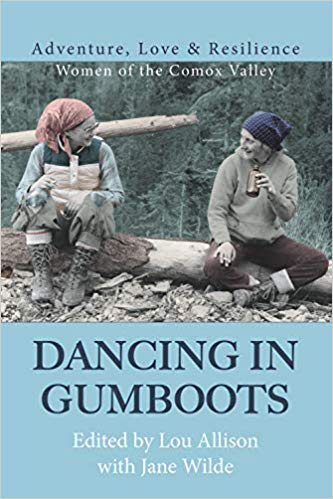
Dancing in Gumboots: Adventure, Love & Resilience: Women of the Comox Valley
Review By Shirley McDonald
May 9, 2019
BC Studies no. 202 Summer 2019 | p. 185-187
Dancing in Gumboots: Adventure, Love & Resilience: Women of the Comox Valley is a collection of memoirs by thirty-two women who came to the Comox Valley on Vancouver Island in the 1970s. Drawn by an illusive utopian desire to create a better world, they took part in what appears to be an informal back-to-the-land movement. The stories reveal the authors’ various motives to leave cities and jobs and, with naïve optimism, throw themselves into the labour of farming. Some women came from Canada, some from Europe and, as Gerri Minaker relates, some came from the United States to escape the conflicts posed by conscription and the Vietnam War (46). Some came with partners and bought land that, contributor Rosemary Vernon tells readers, was settled by veterans whose service to Canada in the First World War had been rewarded with fifty acres and materials to build a house (71). Some bought cultivated land from retiring farmers whose parents had settled there. Others came to “homestead,” Sandy Kennedy writes, having been “bedazzled by the lure of self-sufficiency” (32). They built dwellings and carved out gardens from untouched and often rough land.
Some women left their careers behind them and sought new ways to make a living. Some came with professional skills and applied them as they contributed to the formation of the Comox Valley community. Lee Bjarnason, for example, had a degree in Early Childhood Education and helped form the Comox Valley’s early childhood education program (59-60). Some of the authors became artists or artisans and founded the Comox Valley Arts Alliance, the Vancouver Island Music Festival, and the Renaissance Fair. A few became tree planters on Vancouver Island, while others became activists who contested logging. They promoted sustainability in the region and defended the surrounding old-growth forests against encroachment by speculators who saw them as places of lucrative resource extraction. “Volunteerism, the lifeblood of small communities, flourished,” writes Kennedy as she recalls her role in forming an environmentalist “action group” that tackled issues such as “the Comox Valley’s plan to pipe raw sewage into nearby waters, herbicide spraying on Vancouver Island, a massive log-booming facility in Baynes Sound, and the storage of nuclear warheads at Nanoose Bay” (36). Later, Kennedy writes, the group formed a “blockade in Strathcona Park and Clayoquot Sound,” which resulted in their “incarceration, court appearances, and house arrest” (36). Due to their activism, many of the women who settled in the Comox Valley became, unconsciously perhaps, allies of the Indigenous community for, as Secwepemc leader Arthur Manuel declares: “In defending the land … we are defending something much larger than Indigenous rights. Our fight today is to preserve the planet in a livable form” (242). All the contributors to the volume seem to have been activists and advocates of social justice.
Numerous authors recall founding the annual Women’s Fair and forming the North Island Women’s Self-Help Network. Indeed, all the women are feminists and embodiments of the ideologies promoted by Germaine Greer and Gloria Steinem, icons of the Second Wave of feminism. In this respect, the collection of memoirs reveals a kind of homogeneity. There is even an allusion to lesbianism. Surprisingly, however, there are no women of colour, and, other than an acknowledgement that the authors “live, work, and play on the traditional lands of the K’omoks First Nations” (5), there is a lack of reference to the region’s Indigenous women. There is a lack of detail, too, in the women’s stories of their settlement experiences. The chapters move rapidly over the women’s personal histories and quickly mention significant events; yet, none of the authors linger on these moments. None invite readers to share their experiences of living in tents over a chilly, rainy winter, or of living without electricity for several years in a house cobbled together from salvaged materials. No one describes what it is like to labour hard to clear a bramble patch or an acre of fallen wood to start a garden. No one tells us what it feels like to dance in gumboots. What the collection lacks in verisimilitude, however, it makes up in photographs. Each story has at least two portraits of the author: one of her “then” and one of her “now”. The pattern creates cohesion. The early photographs feature strikingly beautiful young hippie women in the 1970s, when they arrived in the Comox Valley; the recent ones attest to the fact that each of the authors has aged with dignity and pride in having created a new and, hopefully, sustainable world. Thus, shortcomings aside, the volume is a captivating exposé of the ideologies of a sub-culture or counter culture movement that will be familiar and endearing to many members of the Baby Boom generation.
Works Cited
Dancing in Gumboots: Adventure, Love & Resilience: Women of the Comox Valley. Edited by Lou Allison with Jane Wilde. Caitlin Press, 2018.
Manuel, Arthur, and Ronald Derrickson. The Reconciliation Manifesto: Recovering the Land, Rebuilding the Economy. Preface by Naomi Klein. Lorimer, 2017.
Publication Information
Dancing in Gumboots: Adventure, Love & Resilience: Women of the Comox Valley
Lou Allison and Jane Wilde
Halfmoon Bay: Caitlin Press, 2018. 240 pp. $24.95 paper.
